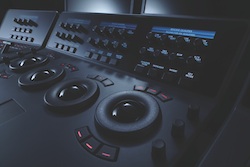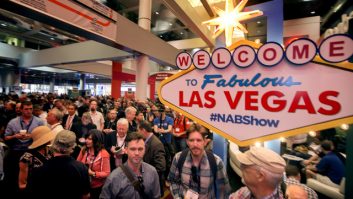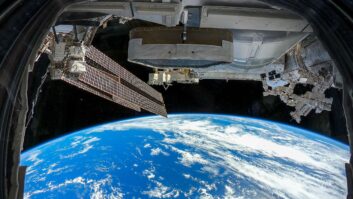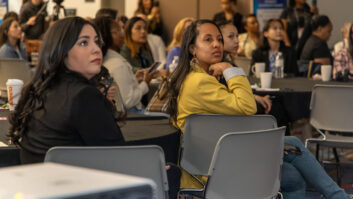
It was fitting that NAB coincided with stereo coverage of The Masters golf championship, as 3D was a dominant topic in Las Vegas. By Carolyn Giardina.
The 3D golf tournament coverage was available on television, via outlets include Cablevision and Comcast; and uniquely, it was streamed live on the internet for viewing with 3D ready laptops or other equipped devices. Live coverage of the final day could be viewed in Vegas, for instance during portions of the Digital Cinema Summit. Meanwhile NVidia, whose 3D Vision technology powers 3D laptops from companies such as Acer, highlighted the possibilities of streaming 3D content to consumers.
The lensing of The Masters, coupled with the anticipation surrounding the 3D coverage of the FIFA World Cup signalled that there would be a growing amount of available 3D content. Meanwhile, there was a general belief that innovation in stereo production technology is occurring at a rapid pace.
“A lot of wheels are spinning,” said Peter Ludé, senior technology executive at Sony. “I absolutely believe there will be more announcements about 3D channels — and about other genres and applications where people will be at least experimenting with 3D content acquisition. We are hearing inquiries coming in from all over the world.”
Still, tempering the excitement was concern about the quality of 3D. “Poorly executed 3D is harmful, and it threatens its long term success,” stated keynote speaker Hiroshi Yoshioka, Sony’s executive deputy president and president of the consumer products and devices group.
The cry for quality — heard from broadcasters, filmmakers, manufacturers and other stakeholders — was prompted in large part by the recent release of the 2D-to-3D converted version of Clash of the Titans which was met with widespread criticism in professional circles. The Warner Bros. movie, which opened one week before NAB got underway, also made 2D-to-3D conversion a highly charged topic during NAB, particularly in the feature film business.
But while quality was an issue, many believe that conversion is also inevitable. For live broadcasting, 2D-to-3D conversion may be used for additional camera positions during 3D productions.
One of the most discussed conversion tools at NAB was JVC’s IF-2D3D1 box, designed to convert live or recorded 2D video into stereoscopic video in realtime. It can also be used as a broadcast mixer, with features such as a waveform monitor and separate left/right inputs for stereo cameras (which could be viewed on the screen either in 3D or side by side).
Dave Walton, assistant VP marketing and communication at JVC Professional suggested that a combination of 3D acquisition and conversion is inevitable for live sports, a method that he likened to the early days of HD when there was HD acquired and upconverted material. “We see (the JVC converter) being a very helpful tool in trucks for live broadcasts. Companies for instance can do a cutaway to a blimp shot and run it through the converter.”
But Walton maintained realistic expectations. “It is important that the director looks at the image first — hopefully the stereographer,” he said. “It is not perfect. There are going to be some things that work great, and others not so great. It is an imperfect science, and it will probably always be an imperfect science.”
With a caveat, Sony’s Ludé said: “We don’t believe (2D-to-3D conversion) is viable for the professional market. We think we are many years away from having an effective algorithm that can be reliable to create a 3D image out of 2D content. On the other hand, a feature built into a TV set, maybe there is some market need for that. That is the subject of some debate … I think there will be some synthesised 2D to 3D; a good example is a blimp shot. But something like an interview, you can’t fake that, you need to do that in native 3D.”
At NAB, Sony also showed some developing ‘in between’ technology as a demonstration. Essentially, Sony used a computer algorithm to created an accurate stereo depth map from a fixed camera position. “This is something we are experimenting with for broadcasts,” Ludé explained. Meanwhile, demonstrating Sony’s range of stereo tools, the new All Mobile Video 3D OB truck was on the Sony stand, complete with Sony monitors, switchers and cameras.
Sony, as well as Panasonic, is developing a full line of stereo products from cameras to monitors. But strategies vary. Grass Valley for instance is not betting the farm on 3D, and is therefore working to add 3D capabilities into its existing products.
“It’s really about making 3D easier to produce without added investment,” Grass Valley CTO Ray Baldock explained. “I don’t think people want to buy 3D specific gear. They want to repurpose what they have. We are offing our customers the opportunity to upgrade existing product to add 3D modes. For instance the switcher will have a software upgrade released later this year. In the servers, we are now offering an update that effectively doubles the number of channels.”
NVidia brought a complete 3D message to NAB. The company demonstrated a digital video pipeline for 3D broadcasting in which each tool was powered with its Quadro 3D technology, including a camera and portable workstation running software applications. That includes realtime 3D acquisition, image processing, compositing and graphics. “We can also encode and distribute to the home,” said director of marketing Danny Shapiro, who showed clips from The Masters.
NVidia’s 3D Vision technology is designed to enable a new ‘3D PC’ product category. Addressing content, NVidia’s VP corporate marketing Rob Csongor reported that upcoming live streaming events are in the planning stages. Additionally, he estimated 75% of all video games are also being planned to offer some 3D capabilities. And, a range of 3D still cameras and camcorders are coming to market.
New toolkits
On the subject of stereo post production, there is a consistent message amongst manufacturers, who agree that stereo needs to be part of the feature set in commonly used systems. Though not a 3D-specific announcement, Blackmagic Design — at its first NAB since it acquired colour grading system maker da Vinci — grabbed a notable amount of attention with a new software-only version of DaVinci Resolve 7.0 that includes support for the Mac OS X platforms — and starts at a mere $995 (though the version with the trackballs pictured above still unsurprisingly costs substantially more).
On the 3D front, Blackmagic emphasised its DeckLink HD Extreme 3D, which features single and dual channel SDI capture and playback for both 2D and now 3D stereoscopic workflows; and HDLink, designed to enable full resolution 2D/3D HDTV and 2K monitoring for DVI, DisplayPort and HDMI monitors. Also in grading, FilmLight introducing a turnkey, entry level version of its Baselight colour grading system. The company also previewed its Baselight 4.2 software, which includes a new toolkit for stereoscopic 3D grading. The stereo capabilities are included in all Baselights, including the entry level model though this version is not recommended for stereo jobs as more horsepower many be required.
Fresh off its successful use on Avatar, Quantel was busy bringing its 3D toolset to broadcasters as well as filmmakers. Its version 5 for eQ, iQ and Pablo includes a new Stereo3D timeline that allows each eye to be viewed and worked on individually or both at the same time. Also at NAB, Quantel and Cinnafilm demonstrated their latest combined development. “We are working collaboratively with Cinnafilm to integrate their Dark Energy technology with our post production systems,” said Quantel Director of Marketing Steve Owen.
Autodesk was on hand with the 2011 releases of Flame, Flare, Smoke and Lustre — all of which offer new 3D finishing capabilities, augmenting the stereo capabilities of Maya 2011. Features include a stereoscopic camera rig. “Last year we introduced a stereo camera rig into Maya,” explained Autodesk’s senior industry Marketing Manager Maurice Patel. “Now we introduced the same camera rig support in Flame and Smoke. That means you can move stereo data from Maya into your finishing systems. So it is consistent.”
AJA Video Systems revealed at NAB that it is working with CineForm to provide Mac and Windows-based editing and effects software users with new ways to output stereoscopic 3D material using its Kona 3 video capture card through CineForm’s Neo3D software.






